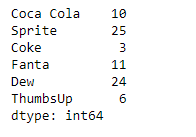Python | Pandas Series.pop()
Last Updated :
11 Feb, 2019
Pandas series is a One-dimensional ndarray with axis labels. The labels need not be unique but must be a hashable type. The object supports both integer- and label-based indexing and provides a host of methods for performing operations involving the index.
Pandas Series.pop() function returns the item corresponding to the passed index label. It also drops the item from the series object.
Syntax: Series.pop(item)
Parameter :
item : str
Returns : popped : Series
Example #1: Use Series.pop() function to pop an element from the given series object.
import pandas as pd
sr = pd.Series([10, 25, 3, 11, 24, 6])
index_ = ['Coca Cola', 'Sprite', 'Coke', 'Fanta', 'Dew', 'ThumbsUp']
sr.index = index_
print(sr)
|
Output :

Now we will use Series.pop() function to pop the entry for ‘Sprite’ in the given Series object.
result = sr.pop(item = 'Sprite')
print(result)
print(sr)
|
Output :


As we can see in the output, the Series.pop() function has successfully popped the entry for the passed label in the given series object.
Example #2 : Use Series.pop() function to pop an element from the given series object. The given series object contains some missing values in it.
import pandas as pd
sr = pd.Series([19.5, 16.8, None, 22.78, None, 20.124, None, 18.1002, None])
print(sr)
|
Output :

Now we will use Series.pop() function to pop the entry corresponding to the 1st index label in the given Series object.
result = sr.pop(item = 1)
print(result)
print(sr)
|
Output :


As we can see in the output, the Series.pop() function has successfully popped the entry for the passed label in the given series object.
Like Article
Suggest improvement
Share your thoughts in the comments
Please Login to comment...